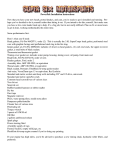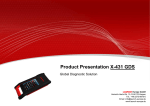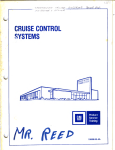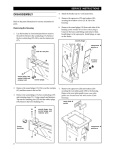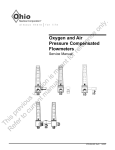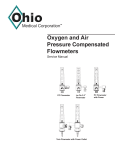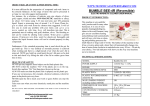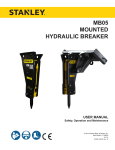Download Engine color, things are not always Blue.
Transcript
Engine color, things are not always Blue. Nothing makes me happier then seeing beautifully restored Comets and Cyclones anytime, and anywhere. And when the owner “pops” the hood and you find everything is restored and painted as if this Comet is factory fresh, well that’s just icing on the cake. But wait a minute; it’s a Ford isn’t it? Aren’t Ford engines painted Blue? Engine color has long been a topic of controversy with Ford and Mercury owners and restorers. And beauty is in the eye of the beholder. But Ford Motor Company did have good reason to paint their engines the way they did. In this article I will be covering Mercury Comets and Cyclones for 1960-1968. Part One: Basic Black In 1958 when Ford Motor Company released its new FE big block series. This all new engine came with an all new paint scheme. The long blocks were painted all Semi Gloss Black. Valve covers and air cleaners were color coded for easy cubic inch identification. All you had to do was check the service manual for the color code. A service technician could take one look and know what engine was in your car. But why were the long blocks painted Semi Gloss Black? Well there was a theory which was quit popular at the time which stated painting an engine black help with heat dissipation. The theory is that black is a better emitter of infrared (heat) energy. A hot engine in a cold surrounding radiates energy from the hot object to the cold. The amount of radiant cooling is (generally) dependent upon the temperature of the emitter (engine) and how efficient the engine is at radiating energy -- its emissivity. This derives from Kirchoff's Law of thermal dynamics where good absorbers are also good emitters. Since black is a good absorber of energy (that's why it's black) it's also a good emitter. A black object emits more radiant energy (cools faster) than a white or gold object that emits less radiant energy per unit of time. Painting an engine black increase the amount of radiant energy emitted by the hot engine to its colder surroundings. But there is a fallacy to the above argument. Most heat energy emitted by the engine is in the invisible infrared portion of the spectrum. What appears to us as black, white, red, or green in the visible spectrum is not what we would see in the infrared spectrum. Any color of paint that uses organic (non-metallic) pigments is black in the infrared spectrum. For example, white paint emits 90-95% depending upon pigment type. Black emits 96%, blue 94%, green 92% and red 91%. The best emissivity surface coating is acetylene soot at 97%. Painting an engine increases radiant cooling but the color of the paint doesn't matter. Part Two: Color my World All Mercury and Comet passenger cars 1960 through the 1965 long blocks were painter Semi Gloss Black when new. The long block includes engine block, intake manifold, cylinder heads, oil pan, and water pump. One thing you need to know when you are painting any Mercury or Comet engine is this. When the engine is assembled on the engine line, the valve covers are painted separate from the engine. When the valve covers are installed, the attaching bolts are left unpainted. In fact the majority of bolts attaching items to the engine are left unpainted when new. Author Bob Mannel in his book, Mustang & Ford Small Block V8 1962 – 1969, list all engine items which are painted and which are left unpainted on Ford small block engines. From what I have read and seen, the same scheme holds true for six cylinder engines. This is one simple visual that does make a big difference. It’s quit common to see this detail overlooked. For 1960 things were simple for the all new Comet with only the 144 cid six cylinder engine. The valve cover and air cleans were painted yellow, Ditzler Paint code 81196. The oil breather caps were painted Semi Gloss Black with the proper decals installed as shown in the pictures below. The examples to left are 144 cubic inch engines in the correct yellow color. All 144 engines form 1960 thru 1963 were painted as above. The 144 engine color scheme was unchanged for its entire run from 1960 thru 1963. This is not the same yellow use on Comet engines in later years. In 1961 the optional 170 cid engine was added to the Comet lineup. This new additions paint scheme differed from the 144, with its valve cover and air cleaner being painter Argent, which is a version of Silver. All 170 cid engines installed in Comets from 1961 thru 1964 used this paint scheme. Ditzler Paint code for these engines is DEE-45 Examples of 170 cubic inch paint scheme 1961 thru 1964 With the introduction of the 260 Cyclone V8 to the 1963 mid-year Comet lineup, Comet now had more muscle then every before. This all new power plant was the first of a long line of V8 power that would be installed in Comets to come. The 260 Cyclone V8 can be identified by its red valve covers and air cleaner. This color was NOT Ford Red. It is very close to Chevrolet Orange-Red Duplicolor DE 1607, or 1970 Mercury “Competition Orange Ditzler Paint 00449. The air cleaner snorkel and heat collector are painted Semi Gloss Black. Below are some examples of the 260 Cyclone V8. The above examples are a 260 Cyclone V8. You can clearly see the special Orange/Red color scheme. Also the snorkel and heat collector can be seen in semi gloss black. Oil filler cap should be semi gloss black also. 1964 brought major changes to the Comet line-up with all new sheet metal and a major facelift. Comet also received two new engines. The six cylinder lineup was given a new 200 cubic inch engine and the 144 was dropped. The V8 line-up was given a new optional 289-4V and retained the 260 Cyclone V8 as well. Early cars built with 260 engines use a light blue color scheme for valve covers and air cleaner. A very good match would me 1970 Ford Grabber Blue. They were NOT painted Ford Corporate Blue. The Ditzler Paint code for this engine is 11297. The new 200 cubic inch six was given an ivory white valve cover and air cleaner. The Ditzler Paint code for both is 81052. The 289 V8 was given Gold Bronze valve covers and air cleaner for all models except the Cyclone. As with the 260 V8s the snorkel and heat collector are painted Semi Gloss Black. The Ditzler paint code for the 289 V8 valve covers and air cleaner is 22362. In January 1964 a sporty Comet Cyclone model was added to the model line-up. The Cyclones were given its own unique Argent paint scheme for its air cleaner. The Ditzler Paint code for this engine is DEE-45 just like the 170 six cylinder. Cyclone 289 4v engine were also given an optional engine dress-up kit which included chrome valve covers, dipstick, and air cleaner top cover as standard. Below are some examples from the 1964 model year. 1964 289-V8 in Bronze Gold and all new 200 six cylinder in Ivory White paint scheme. The 1965 model year brought major changes to the Comet line-up for a second year. Once again Comet received a major facelift. With new sheet metal and new overall look front and rear. The 170 six cylinder engine was dropped from US production vehicles. And an all new 200 cubic inch six cylinder engine was added to the line-up. For the V8 buyer the 260 V8 was dropped, and the 289 was upgraded to 200 horsepower and 225 horsepower versions. The Color scheme changed for 1965 as well. All engines except for the engines install in the Cyclone models used a Bright Yellow color scheme for the valve covers and air cleaners. This is a brighter yellow then used on the earlier 144 engines. The Ditzler paint code number is 80301. I personally used Plasti-Kote “BriteYellow” paint code 376 on my 65 Comet. Everyone has told me it is totally correct. The snorkel and heat collector are painted Semi Gloss Black as they were from the 64 model year.. The Cyclones for 1965 were once again given its own unique Argent paint scheme for its air cleaner. The Ditzler Paint code for this engine again was DEE-45 just like the 1964 models. Cyclone Super 289 engines were also given the optional engine dress-up kit as standard and including chrome valve covers, dipstick, and air cleaner top cover. Below are some examples for the 1965 model year. Above are examples of the 1965 Comet and Cyclone Engines. Notice the Cyclone far right is painted In its unique Argent paint scheme. If it is blue, it is power by Ford. For many years prior to 1966, as we have seen, Ford engines were color-keyed to specific applications and carlines. Starting in 1966, this practice changed. All engine now were painted Ford Corporate Blue. Instead of color-keyed valve covers and air cleaners, the entire engine would be Ford Corporate Blue, like the Ford Blue Oval and the Ford Blue offset dealer signs popping up in 1966 at Ford dealerships. Ford's message for 1966 and beyond was simple--if it is blue, it is power by Ford. As in earlier years, Ford continued to paint the valve covers separate from the engines. Engine long-blocks, which included block, intake manifold, heads, and oil pan, were all painted Ford Blue. Valve covers were installed toward the end of engine assembly using natural metal bolts with integral lock washers. We've learned through observation and conversation with restorers that Duplicolor's Dark Ford Blue (1606) is an accepted color for '66 and later Ford engine restorations. An alternative, when Duplicolor isn't available, is Krylon's Dark FordBlue, which is also the correct shade of dark blue. Plastikote is another paint brand, Royal Blue (1134) an acceptable color for '66 and later. Below is the ad from Ford Motor Company which ran in Sunset Magazine in January 1966. So the next time you “pop” the hood on a beautiful Comet or Cyclone at the local car show remember, there is more to a beautiful engine then just paint.






